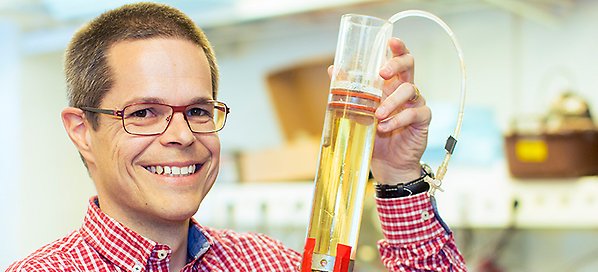He gets to the bottom of lake carbon dioxide emissions

Photo: Mikael Wallerstedt
What part do lakes and watercourses play in climate change? Is it possible to measure human effects on ecosystems? The way to learn more about natural cycles is through broader research collaboration according to Sebastian Sobek, limnologist at the Department of Ecology and Genetics.
Although inland waters such as lakes, reservoirs and water courses account for only three percent of the earth’s land area, they release a significant amount of carbon dioxide into the atmosphere. The carbon dioxide released is about half of the carbon dioxide taken up by land ecosystems such as forests and savannahs. The approximately 100 000 lakes and 500 000 km of water courses in Sweden cover just over 8 percent its land area.
“This is why our lakes are so important for the whole landscape,” says Sebastian Sobek. “The Nordic forest lakes are sources of carbon dioxide and are important to the earth’s carbon cycle. The way carbon is recycled through the earth’s ecosystems determines to a great degree climate and temperatures.”
In 2013 Sebastian Sobek and an international research group published a study in Nature on the major impact inland waters had upon the global carbon cycle. For the first time scientists succeeded in combining several databases and, in this way, they described the release of carbon dioxide from the earth’s inland waters.
“It turned out that water courses such as small streams released most carbon dioxide,” says Sebastian Sobek. “We also saw that unlike forest and land systems, inland waters do not take up carbon dioxide, most of them just give it off all the time. This is why inland waters can affect the balance of the entire cycle.”
These are, however, natural processes. In water systems, which are lowest down in the landscape, organic carbon collects from rotting vegetation, branches and leaves. This becomes food for aquatic bacteria which then breathe out carbon dioxide into the atmosphere. At the same time, a lot of organic particles sink to the bottom of the water and form thick sediment where carbon is stored.
“It is exciting that inland waters are both a carbon dioxide source to the atmosphere and carbon sinks due to their sediment – at the same time!” says Sebastian Sobek.
“What we researchers want to understand is the net balance. One question is, however, how much does mankind affect the carbon balance of inland waters through forestry and agriculture, urbanisation, climate change and so on? Studies have been carried out which try to quantify human impact, but there is still a lot of work to do.”
According to Sebastian Sobek, studying the various components of ecosystems requires interdisciplinary collaboration. Hydrologists contribute their knowledge of water flow and movements through surface and ground water. Meteorologists provide important information regarding the actual exchange of gases, and experts on land ecosystems measure carbon dioxide exchange in the fields and forests. Mathematical models bring together current research and can be used to simulate the dynamics of ecosystems.
“The challenge is to understand what the others are saying since the various disciplines each have their own language. But in principle we all have the same goal: to understand the carbon cycle in the biosphere, how much is stored and how much is released to the atmosphere.”
It was pure chance that Sebastian Sobek became fascinated by aquatic systems. He grew up in a small village in the Black Forest in Germany. He spent his spare time among the trees, mountains and wildlife. His interest in nature was reinforced by a gifted teacher at high school which led to him studying biology at Freiburg University and later at Uppsala University.
“It was quite big step for me to take as I’m from a family which has no academics. I was the first among my relatives to study at a university so I was something of a pioneer.”
He decided on limnology, “because of the holistic perspective, the desire to understand how chemical and physical processes interact with organisms to form an ecosystem.” Sebastian Sobek’s curiosity over how the natural world is interconnected is still his driving force and it is what he himself wants to pass on as a teacher.
“Ecosystems in general and the way mankind affects nature on a grand scale are important things for the general public to know about. And we achieve this through our students. It’s fantastic to work with undergraduates, doctoral students and post-docs and watch them grow and apply what they’ve learned.”
Anneli Björkman
2015-05-21
